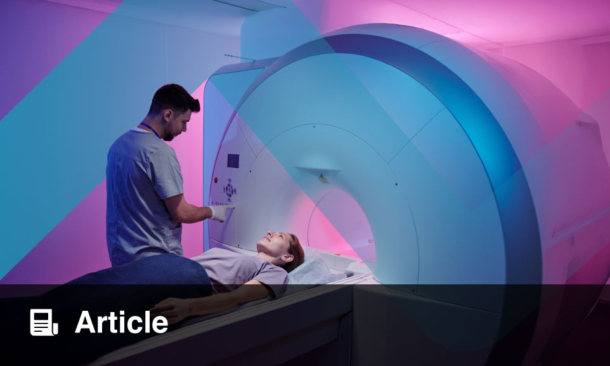The following highlights showcase the most pivotal, innovative research published across multiple therapeutic areas in medicine in 2024. The selected abstracts mark key advancements in healthcare and highlight future avenues for medical innovation.
Citation: EMJ Innov. 2025;9[1]:19-30. https://doi.org/10.33590/emjinnov/HOUG5234
![]()
A Wearable Solution for Voice Disorders: Soft Magnetoelastic Technology
VOICE disorders, often caused by pathological vocal fold conditions or recovery from laryngeal cancer surgeries, are prevalent sources of dysphonia.1 These disorders impair voice quality, pitch, and loudness, significantly impacting patients’ quality of life.
In order to address this issue, a research team based in California, USA, introduced a self-powered, wearable sensing-actuation system based on soft magnetoelasticity that enables assisted speaking without relying on vocal fold vibrations.
This device has been designed to be lightweight (approximately 7.2 g) and skin-like, with a modulus of 7.83×10⁵ Pa, stability against perspiration, and a maximum stretchability of 164%. Its sensing component captures extrinsic laryngeal muscle movements and converts them into high-fidelity electrical signals. These signals are analysed using machine learning algorithms to achieve a speech recognition accuracy of 94.68%. The system’s actuation component translates these electrical signals into voice signals, bypassing the vocal folds entirely. This non-invasive device holds the potential to restore normal voice function, significantly improving the quality of life for individuals with dysfunctional vocal folds.
Voice is integral to human communication, serving as a medium for expression, emotion, and connection. Disorders affecting the vocal fold, the primary voice-generating organs, severely disrupt social interaction and community integration. Voice disorders, including vocal fold polyps, paralysis, nodules, keratosis, and adductor spasmodic dysphonia, affect 29.9% of people at some point in their lives. Additionally, 7.0% of individuals experience ongoing voice problems, and 7.2% of employed individuals report work absences due to these issues. Laryngeal surgeries, often necessary for cancer treatment, can exacerbate these challenges, requiring lengthy recovery periods and absolute voice rest lasting months.
The research team highlighted that existing solutions, such as electrolarynx devices, “talk boxes”, or trachea-oesophageal puncture procedures, can be invasive, inconvenient, or uncomfortable. Voice therapy and surgical interventions, while effective, demand prolonged recovery times, ranging from 3 months to a year. These limitations underscore the urgent need for wearable, non-invasive medical devices to assist patients in communicating during treatment and recovery.
This novel magnetoelastic wearable system represents a transformative approach. By enabling speech without vocal fold involvement, it offers a comfortable, efficient, and practical alternative to traditional solutions. With its potential to restore communication, researchers note that this technology addresses a critical need in healthcare today, empowering patients to navigate recovery with confidence and dignity.
Revolutionary Bioink Paves Way for Advanced Lung Engineering
3D-PRINTING has become a powerful tool in personalised medicine, allowing for the creation of tailored tissue-engineering constructs at lower costs.2 However, one major limitation has been the lack of diverse and functional biopolymeric hydrogels for bioinks, which restricts the range of applications in regenerative medicine. A new composite bioink could change this landscape.
This study introduced a bioink combining methacrylated mucin (MuMA), a photo-cross-linkable derivative of mucin, with hyaluronic acid (HA). Mucin, known for its role in mucus and its hydrogel properties, has been underutilised in bioink applications. However, its unique features offer great promise. HA, a vital component of the extracellular matrix, enhances the ink’s viscosity and printability while also being mucoadhesive, further improving the bioink’s functionality.
The bioink is stabilised by photo-cross-linking with 405 nm light, which ensures cell protection during the printing process without compromising cell viability. Rheological tests showed that the ink exhibits shear-thinning behaviour, which improves its handling during printing and further aids in protecting cells. Additionally, the presence of HA enhances the viscosity of the MuMA-based bioink.
Printed scaffolds demonstrated a porous structure, which is crucial for nutrient transport and cellular migration. After 4 weeks in phosphate-buffered saline, the scaffolds maintained 70% of their original mass, indicating strong stability. Biocompatibility assessments using lung epithelial cells (L-132) confirmed cell attachment and growth, suggesting that this bioink is particularly suited for lung tissue engineering.
The versatility of this bioink opens up promising possibilities not only in lung tissue engineering but also in a wide array of biomedical applications. This advancement represents a significant step forward in the use of 3D bioprinting for patient-specific treatments, enhancing the potential for future regenerative therapies.
Gene Therapy Shows Promise in Treating Congenital Deafness
A RECENT clinical trial has brought promising results for children suffering from autosomal recessive deafness 9, a form of congenital deafness caused by mutations in the OTOF gene leading to severe-to-complete, bilateral hearing loss.3 Currently, no pharmacological treatment exists for congenital deafness, making this trial a significant step forward.
The trial, which took place between October 2022–June 2023, involved six children aged 1–18 years with confirmed OTOF mutations and severe hearing loss. Researchers administered a single injection of adeno-associated virus (AAV1) carrying the human OTOF gene (AAV1-hOTOF) directly into the cochlea via the round window. The goal was to assess the therapy’s safety and efficacy, with a primary focus on any dose-limiting toxicity occurring within 6 weeks.
The trial was conducted at a single centre, and all six participants completed follow-up visits up to 26 weeks post-treatment. Remarkably, no dose-limiting toxicity or serious adverse events were reported. A total of 48 adverse events occurred, but 96% were mild (Grades 1–2), and only 4% were moderate (Grade 3), with one participant showing a reduced neutrophil count.
The results demonstrated significant improvements in auditory function. Five of the six children exhibited hearing recovery, with average auditory brainstem response (ABR) thresholds improving by 40–57 dB. The child receiving the lowest dose (9×1011 vector genomes) showed the most dramatic improvement, with ABR thresholds improving from over 95 dB at baseline to 45 dB at 26 weeks. Those receiving higher doses saw similar gains in ABR thresholds.
Importantly, speech perception was also enhanced in children with hearing recovery, indicating that the therapy may have long-lasting benefits beyond just hearing restoration.
This trial provides the first evidence of gene therapy’s safety and efficacy for treating autosomal recessive deafness 9, offering hope for future therapeutic options for children with this previously untreatable condition.
Saliva-Based Test Could Revolutionise Early Breast Cancer Detection
BREAST cancer remains one of the most prevalent cancers among women, reinforcing the urgent need for more effective and accessible detection methods.4 A groundbreaking study is offering a promising solution by utilising salivary biomarkers for the non-invasive detection of breast cancer, paving the way for a faster, more efficient screening process.
In this innovative approach, researchers adapted commercially available, disposable strips, similar to those used for glucose testing, to detect breast cancer biomarkers HER2 and CA15-3, which are known to play a critical role in the progression of breast cancer. The new test demonstrated remarkable sensitivity, with detection limits as low as 1 fg/mL. This is significantly more sensitive than traditional ELISA, which typically detects levels in the range of 1–4 ng/mL.
The testing mechanism is based on a synchronised double-pulse method that applies a series of 10 rapid voltage pulses to a sensing strip electrode. This process amplifies the detected signal, providing highly accurate results. The sensor’s sensitivity levels were found to be approximately 70/dec for HER2 and 30/dec for CA15-3, indicating the test’s robustness in detecting even minute concentrations of biomarkers.
One of the most compelling advantages of this technique is its speed and minimal sample requirement. Testing takes less than 15 milliseconds and requires only 3 µL of saliva, making it a highly efficient and user-friendly option. The simplicity of the test and its potential for widespread use could dramatically improve early breast cancer detection, particularly for those with limited access to traditional screening methods.
New EV-GLYPH Assay Identifies Early Malignant Development in Lung Cancer
A NEW diagnostic tool, the EV-GLYPH assay, has demonstrated potential for non-invasive detection of early-stage lung cancer by analysing glycan patterns on small extracellular vesicles (sEV) released by cancer cells.5
The EV-GLYPH assay combines a microfluidic platform with surface-enhanced Raman scattering to profile sEV glycosylation. These glycans, reflective of their tumour cell origins, provide critical insights into cancer initiation, progression, and resistance to treatment.
In the clinical study, which consisted of 40 patients, the EV-GLYPH assay successfully distinguished between early-stage malignant lung nodules and benign lung nodules. This represents a significant step forward as current technologies struggle to analyse the trace amounts of tumour-derived sEVs in circulation. The lead researchers noted that this is the first successful identification of distinct sEV glycan signatures between normal and cancerous lung cells, opening new doors for early detection and improved patient outcomes.
Glycosylation, a common post-translational modification of proteins, regulates many fundamental biological processes under normal and pathological conditions and is often altered in cancer, promoting tumour proliferation, invasion, and metastasis. By focusing on glycan patterns, the EV-GLYPH assay provides a minimally invasive method to monitor lung cancer progression and potentially guide therapeutic decisions. The success of this assay could transform cancer diagnostics, providing clinicians with a powerful new tool to detect lung cancer in its early stages, when treatment is most effective.
Platelet Reactivity Expression Score Predicts Cardiovascular Risk
A NOVEL tool, the Platelet Reactivity ExpreSsion Score (PRESS), has shown promise in identifying individuals with hyperreactive platelets and an increased risk of cardiovascular events.6 The development of this tool opens the possibility for a personalised approach to antithrombotic therapy for cardiovascular risk reduction.
Platelets play a central role in atherothrombosis, yet methods to identify individuals with heightened platelet reactivity are limited. Recent research aimed to explore the relationship between hyperreactive platelets and cardiovascular events, introducing PRESS as an innovative tool for this purpose. The research focused on patients with peripheral artery disease (PAD), a condition associated with high cardiovascular risk, and incorporated platelet aggregation tests and RNA sequencing to develop PRESS. This tool was evaluated for its ability to predict platelet hyperreactivity and associated cardiovascular events in both clinical and healthy populations.
Platelet aggregation responses to 0.4 µM epinephrine were analysed in patients with PAD. Those with hyperreactive platelets (>60% aggregation) experienced a significantly higher incidence of the 30-day primary cardiovascular endpoint (37.2%) compared to non-hyperreactive individuals (15.3%), with an adjusted hazard ratio of 2.76 (95% CI: 1.5–5.1; p=0.002). PRESS demonstrated strong predictive ability in cross-validation within the PAD cohort (area under the curve: 0.81; 95% CI: 0.68–0.94; n=84) and in an independent healthy cohort (area under the curve: 0.77; 95% CI: 0.75–0.79; n=35). Additionally, patients with PAD with PRESS scores above the median showed a higher risk of future cardiovascular events (adjusted hazard ratio: 1.90; 95% CI: 1.07–3.36; p=0.027; n=29).
The findings highlight PRESS as a valuable tool for identifying platelet hyperreactivity and cardiovascular risk, with significant implications for clinical practice. By enabling personalised risk assessment, PRESS offers the potential to tailor antithrombotic therapies to individual patient profiles, optimising outcomes and reducing adverse events. Future integration of PRESS into routine cardiovascular risk assessments could transform patient care by enhancing prevention strategies and improving treatment precision.
Revolutionising Gynaecologic Surgery: Transvaginal Hysterectomy with Single-Port Robot
THE FIRST transvaginal Natural Orifice Transluminal Endoscopic Surgery (NOTES) hysterectomy was performed on 11 November 2023, at Baylor College of Medicine, Texas, USA.7 This groundbreaking case report demonstrated the feasibility and success of the new da Vinci single port (SP) robotic system for transvaginal NOTES hysterectomy, highlighting a key advancement in the field of gynaecologic surgery.
Whilst transvaginal NOTES has gained popularity since its inception in 2012, challenges in suturing, dissection, and triangulation of traditional NOTES have limited its application for vaginal procedures. Nevertheless, the author has successfully performed over 300 transvaginal NOTES using the robotic da Vinci Xi system for hysterectomy, myomectomy, sacrocolpopexy, and all stages of endometriosis surgeries. The latest advancement, however, is the new da Vinci SP platform, specifically designed for single-port surgery, with robotic elbows that enable “wristed” movements. And on 11 November 2023, the first instance of transvaginal NOTES for gynaecologic procedures with this new advanced platform was reported.
The case report details the 10 steps taken to complete the procedure: patient position (dorsal lithotomy), temporary ureteral stent, transvaginal surgery, port placement and trocar locations, transvaginal robotic SP docking, robotic hysterectomy, ovarian suspension, abdominal wall omental adhesiolysis, undocking and specimen removal, and vaginal cuff closure. Of note, after the completion of the hysterectomy, the specimen is displaced into the lower abdomen, giving the surgeon a unique opportunity to survey the entire abdominal cavity, enabling additional procedures to be carried out on the robotic platform, such as oophoropexy to the respective lateral pelvic sidewall.
Following the successful procedure, the patient was discharged on the same day. Whilst no significant issues arose during the post-operative course, pathology results revealed adenomyosis and endometriosis after the comprehensive surgery. The feasibility and safety seen in this case report warrant validation from further studies with larger sample sizes before employment of this advanced platform.
3D-Printed Sweat Monitor Redefines Real-Time Health Tracking
A NEW wearable health monitor, fabricated using advanced 3D printing and nanotechnology, is set to transform noninvasive health monitoring by providing real-time insights into an individual’s physiological state through sweat analysis.8
The health monitor integrates microfluidic channels and single-atom catalyst-based bioassays to measure sweat rate and key biomarkers, including glucose, lactate, and uric acid concentrations. Developed through a unique one-step continuous manufacturing process, the health monitor addresses longstanding issues of contamination and evaporation seen in traditional sweat sampling methods.
Using direct ink writing, researchers created self-supporting microfluidic structures capable of harvesting sweat directly from the skin without the need for sacrificial materials, addressing the contamination and sweat evaporation issues associated with traditional sampling methods. A pick-and-place strategy integrated bioassays into the device during fabrication, significantly improving manufacturing efficiency. The incorporation of single-atom catalysts enhances the sensitivity and accuracy of colorimetric bioassays, enabling precise measurements.
In a feasibility study conducted on human participants, the device demonstrated its reliability and functionality, delivering quantitative, in situ results during physical exercise. The ability to continuously monitor biomarkers such as glucose and lactate offers potential applications for managing chronic diseases.
This device promises to usher in a new era of accessible, real-time health data, enabling individuals and healthcare professionals to make informed decisions about their well-being.
Gene Editing Shows Promise for Hereditary Angioedema Attack Reduction
HEREDITARY angioedema (HAE) is a rare genetic disorder that leads to severe and unpredictable swelling attacks, which can be life-threatening, particularly when affecting the airway.9 The condition, driven by dysregulation of the contact activation pathway, increases the production of bradykinin, causing elevated vascular permeability and subsequent swelling.
Current treatments primarily aim to reduce bradykinin levels through plasma kallikrein inhibitors, but these therapies often require lifelong administration and do not always prevent attacks. NTLA-2002 is an in vivo gene-editing therapy based on CRISPR-associated protein 9 (Cas9) technology, designed to provide long-term control of HAE with a single treatment. It targets the KLKB1 gene, which encodes plasma prekallikrein, the precursor to plasma kallikrein, and seeks to permanently reduce plasma kallikrein levels by editing the KLKB1 gene in the liver.
In the Phase I portion of a combined Phase I–II trial, NTLA-2002 was administered as a single dose at 25 mg, 50 mg, or 75 mg to 10 adult patients with HAE. The primary goal of the trial was to assess the safety and side-effect profile of NTLA-2002, while secondary and exploratory endpoints focused on pharmacokinetics, pharmacodynamics, and clinical efficacy, particularly in terms of investigator-confirmed angioedema attacks.
The most common adverse events reported were infusion-related reactions and fatigue; however, there were no dose-limiting toxic effects, serious adverse events, or clinically significant laboratory findings. Dose-dependent reductions in plasma kallikrein levels were observed across all dose groups, with a reduction of 67% in the 25 mg group, 84% in the 50 mg group, and 95% in the 75 mg group. Similarly, the number of angioedema attacks per month showed significant reductions, including 91% in the 2 mg group, 97% in the 50 mg group, and 80% in the 75 mg group.
Across all dose groups, the mean reduction in angioedema attacks was 95%, demonstrating the consistent efficacy of NTLA-2002 in reducing both plasma kallikrein levels and attack frequency.
These results indicate that NTLA-2002 holds promise as a one-time, durable treatment option for HAE, potentially offering long-term control without the need for lifelong administration of conventional therapies. However, further studies with larger sample sizes and longer follow-up will be necessary to confirm these findings and better understand the long-term safety and efficacy of NTLA-2002.
Automation in Custom Ocular Prosthesis Manufacturing: A Clinical Leap Forward
A FULLY automated digital process for designing and manufacturing custom ocular prostheses has been developed, offering significant improvements in efficiency, reproducibility, and accessibility compared to traditional methods.10
Millions of people require ocular prostheses due to eye loss or congenital conditions, with current manufacturing processes reliant on skilled ocularists engaging in time-intensive manual methods. These traditional techniques often result in variable outcomes and extended wait times for patients. While additive manufacturing holds potential, existing approaches remain partially manual, requiring substantial expertise. To address these limitations, researchers have created an automated end-to-end digital workflow that incorporates advanced imaging and 3D printing technologies to streamline prosthesis production.
The process begins with imaging the patient’s eye socket using anterior segment optical coherence tomography (AS-OCT). A statistical shape model predicts the optimal prosthesis shape, even when surface data are incomplete. A colour-characterised image of the healthy eye is used to replicate its appearance on the prosthesis. The design is then produced using a multi-material, full-colour 3D printer and undergoes post-processing to ensure compliance with regulatory standards. In a study involving 10 clinical patients, the new process used five times less labour time than traditional methods. Furthermore, the process delivered consistent, high-quality prostheses with superior reproducibility.
This innovation holds transformative potential for clinical practice, reducing patient wait times and improving accessibility to high-quality prostheses. By minimising dependence on skilled labour, the approach could alleviate bottlenecks in service delivery while maintaining or improving aesthetic outcomes. Future developments may focus on enhancing material properties, refining procedural workflows, and expanding applications to other prosthetic types. With broader adoption, this technology could significantly elevate standards of care in prosthetic eye manufacturing, enhancing both patient outcomes and clinical efficiency.







